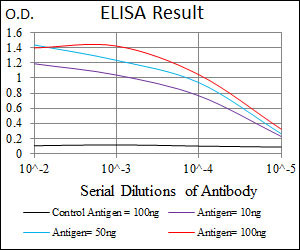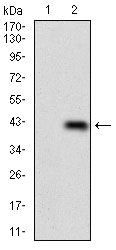PLAGL1 Antibody
Purified Mouse Monoclonal Antibody
- SPECIFICATION
- CITATIONS
- PROTOCOLS
- BACKGROUND

Application
| WB, E |
|---|---|
| Primary Accession | Q9UM63 |
| Reactivity | Human |
| Host | Mouse |
| Clonality | Monoclonal |
| Clone Names | 8F9D12 |
| Isotype | IgG2b |
| Calculated MW | 50.8kDa |
| Description | This gene encodes a C2H2 zinc finger protein with transactivation and DNA-binding activities. It has been shown to have anti-proliferative properties, and thus thought to function as a tumor suppressor. In addition, overexpression of this gene during fetal development is believed to underlie the rare disorder, transient neonatal diabetes mellitus (TNDM). This gene is imprinted, with preferential expression of the paternal allele in many tissues, however, biallelic expression has been noted in peripheral blood leucocytes. A recent study reports that tissue-specific imprinting results from variable utilization of monoallelic and biallelic promoters. Many transcript variants differing in the 5' UTR and encoding two different isoforms, have been found for this gene. |
| Immunogen | Purified recombinant fragment of human PLAGL1 (AA: 118-222) expressed in E. Coli. |
| Formulation | Purified antibody in PBS with 0.05% sodium azide |
| Gene ID | 5325 |
|---|---|
| Other Names | Zinc finger protein PLAGL1, Lost on transformation 1, LOT-1, Pleiomorphic adenoma-like protein 1, Tumor suppressor ZAC, PLAGL1, LOT1, ZAC |
| Dilution | WB~~1/500 - 1/2000 E~~1/10000 |
| Storage | Maintain refrigerated at 2-8°C for up to 6 months. For long term storage store at -20°C in small aliquots to prevent freeze-thaw cycles. |
| Precautions | PLAGL1 Antibody is for research use only and not for use in diagnostic or therapeutic procedures. |
| Name | PLAGL1 |
|---|---|
| Synonyms | LOT1, ZAC |
| Function | Acts as a transcriptional activator (PubMed:9722527). Involved in the transcriptional regulation of type 1 receptor for pituitary adenylate cyclase-activating polypeptide. |
| Cellular Location | Nucleus |

Thousands of laboratories across the world have published research that depended on the performance of antibodies from Abcepta to advance their research. Check out links to articles that cite our products in major peer-reviewed journals, organized by research category.
info@abcepta.com, and receive a free "I Love Antibodies" mug.
Provided below are standard protocols that you may find useful for product applications.
Background
This gene encodes a C2H2 zinc finger protein with transactivation and DNA-binding activities. It has been shown to have anti-proliferative properties, and thus thought to function as a tumor suppressor. In addition, overexpression of this gene during fetal development is believed to underlie the rare disorder, transient neonatal diabetes mellitus (TNDM). This gene is imprinted, with preferential expression of the paternal allele in many tissues, however, biallelic expression has been noted in peripheral blood leucocytes. A recent study reports that tissue-specific imprinting results from variable utilization of monoallelic and biallelic promoters. Many transcript variants differing in the 5' UTR and encoding two different isoforms, have been found for this gene. ;
References
1. J Biomed Sci. 2012 Nov 15;19:95. 2. Exp Cell Res. 2011 Dec 10;317(20):2925-37.
If you have used an Abcepta product and would like to share how it has performed, please click on the "Submit Review" button and provide the requested information. Our staff will examine and post your review and contact you if needed.
If you have any additional inquiries please email technical services at tech@abcepta.com.













 Foundational characteristics of cancer include proliferation, angiogenesis, migration, evasion of apoptosis, and cellular immortality. Find key markers for these cellular processes and antibodies to detect them.
Foundational characteristics of cancer include proliferation, angiogenesis, migration, evasion of apoptosis, and cellular immortality. Find key markers for these cellular processes and antibodies to detect them. The SUMOplot™ Analysis Program predicts and scores sumoylation sites in your protein. SUMOylation is a post-translational modification involved in various cellular processes, such as nuclear-cytosolic transport, transcriptional regulation, apoptosis, protein stability, response to stress, and progression through the cell cycle.
The SUMOplot™ Analysis Program predicts and scores sumoylation sites in your protein. SUMOylation is a post-translational modification involved in various cellular processes, such as nuclear-cytosolic transport, transcriptional regulation, apoptosis, protein stability, response to stress, and progression through the cell cycle. The Autophagy Receptor Motif Plotter predicts and scores autophagy receptor binding sites in your protein. Identifying proteins connected to this pathway is critical to understanding the role of autophagy in physiological as well as pathological processes such as development, differentiation, neurodegenerative diseases, stress, infection, and cancer.
The Autophagy Receptor Motif Plotter predicts and scores autophagy receptor binding sites in your protein. Identifying proteins connected to this pathway is critical to understanding the role of autophagy in physiological as well as pathological processes such as development, differentiation, neurodegenerative diseases, stress, infection, and cancer.




